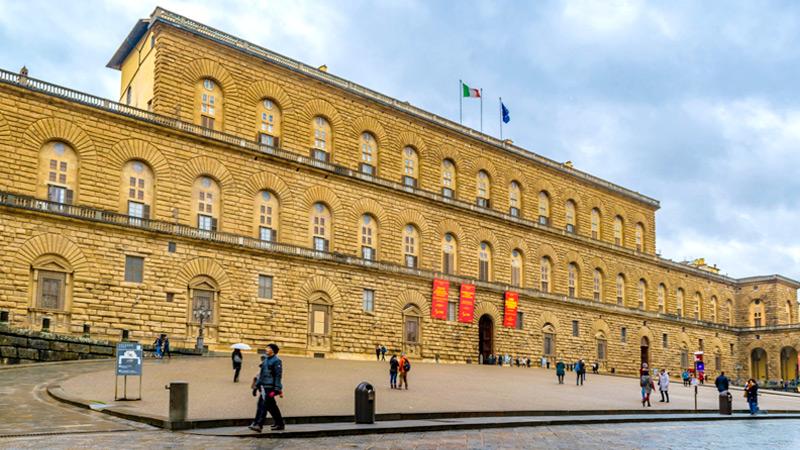
It is amazing; it is history as well as humanity that spans centuries, the collection of artifacts assembled and arranged accordingly as the years dissolve from one to another the way summer does to the seasons. Worked out manually with hardly any medium for research or guidelines, Pitti Palace in Florence stands out as a giant storage of human talent springing from tears, hard work, conviction, spirituality, and above all, self reliance.
All these put together, this monument is a fantastic testimony to the glories of the world and the spectacular wonder put on canvas by the great Masters of by-gone eras.
Pitti Palace consists of the Galleria Palatina, ‘Ex-Reali’ Apartment, Galleria d’ Arte Moderna - Museo degli Argenti-Giardino de Bobol that are carved and divided into different massive collections with details making it easy for all to study and understand each and every painting or artifact. A very prominent Florentine merchant, Luca Pitti, in the mid-1440s decided to invest his amassed wealth that had reached its apex, on something useful for his fellow Florentines.
He lived in a magnificent manor, a palace befitting a family such as the Pittis.
Pitti Palace
He decided to build something more than his manor and it resulted in the Pitti Palace with a huge and wide facade as entry to this sumptuous treasure trove. An appropriate site was picked, an extensive terrain taking up the whole eastern slope of the Boboil Hill, a short distance from the city centre and yet outside, for the setting to be secluded and peaceful.
The site was soon razed to make way for the exciting palace to rise with the best architect of the day, Fillipo Brunselleschi designing and constructing it. Unfortunately, he died before the actual building got under way in 1446. Luca Pitti also died in 1472 due to personal problems and dreaded financial setbacks brought about by his rivals, the Medicis. They forced him to suspend work and the building stood still until 1549. However, Elenora of Toledo, the wife of Grandduke Cosmo de Medici, purchased the huge undone structure and set about transforming it into the grandducal palace as it stands today.
The building was purchased some years ago by the highly celebrated lady, Leonara di Toledo who was the Duchess of Florence, on the advice of her husband, the much venerated Duke of Florence. The building underwent colossal change with a mass of wealth being invested to make it as it is today. It has great gardens extending to hill and dale, filled with all types of cultivated and wild plants.
I cannot express their splendour and magnitude in words. One has to keep on gazing to absorb their magnificence. Never have I seen such glorious landscaping that combine modernity with old world charm plucked from the centuries gone by.
The renovation project was begun by Bartolomeo Amman, a renowned architect of the time who closed two of the three facades and built enormous windows in their place. He also added impressive courtyards beyond the main entrance.
The building extended three to four more courtyards and a man-made grotto containing a grandiose stands tall. When he died, it was continued in 1550, first by Ammannati and then by Buonotalenti (1853). Two projects were later drawn by Alfonso Parigi, Giulio’s son.
Thus, this marvel of the world became the property of the Savoys when Florence was briefly the capital of Italy, (1865 - 1871) later to be bequeathed by King Vittorio Emanuel 111 to the Italian Government in 1919 and has since been the State Museum.
Galleria Palatina
The Galleria Palatina is also called ‘Ex-Real Apartments’ located on the second floor of Palazzo Pitti. The main entrance leads to the spacious and endearing courtyard.
Galleria Palatina is one of Italy’s major museums where works are displayed in splendid halls, richly decorated with gilding stucco reliefs, frescos, and furnished with priceless antiques.
The major part of the collection is devoted to 16th and 17th century Italian Masters, foremost among them being Raphael, Andrea del Sarto, the Florentine mannerists such as Pontoromo and Bronzino as well as Salvator Rosa, Titan, Tintoretto and Veronese, the great Venetian Master of the same era. The Galleria also includes many Flemish and Dutch such as the great Rubens. Sutermans and van Poelenberg.
These collections surpass one another in the magnificence of creativity and imagination.
As we wade through these treasure troves of multifaceted brilliance, we are shaken by their skills and exuberance. They left lasting impressions to their countrymen who have passed down those legacies to all art lovers around the world and still continue.
All painters and sculptors ranging from classicism to Romanticism hold their own identities with fervour and never diminish with time. Like time and tide they go on and on.
